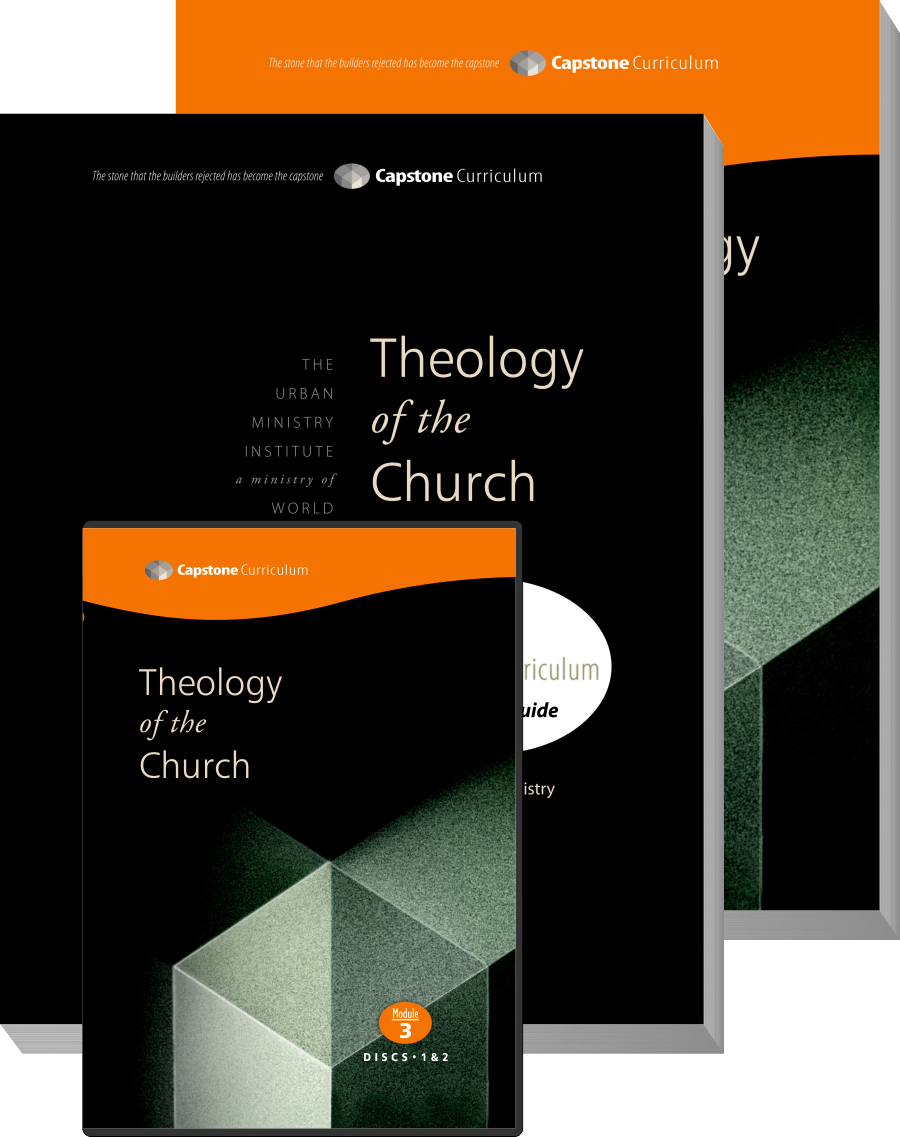 Module 3: Theology of the Church
Module 3: Theology of the Church
The Church of God in Jesus Christ is one of the most refreshing and important themes of all the Scriptures. Jesus of Nazareth, through his death, burial, and resurrection, has been exalted as head over his new people, those called to represent him in the earth and bear witness of his already/not yet Kingdom. To understand the Church’s role in God’s kingdom program is critical to every facet of personal and corporate discipleship; there is no discipleship or salvation apart from God’s saving action in the Church. Grasping what God is doing in and through his people empowers God’s leader to represent him with wisdom and honor. The Church is foreshadowed in God's exalted purpose to bring glory to himself by saving a new humanity through his covenant with Abraham. Through its worship, witness, and good works, the Church through the ages displays the unity, holiness, universality, and apostolicity of its communion. In the Church, God displays his kingdom life and shares his offer of grace to the world.
Course Details
Lesson 1: The Church Foreshadowed in God's Plan
Lesson 2: The Church at Worship
Lesson 3: The Church as Witness
Lesson 4: The Church at Work
Format
Mentor Guide: 275 page book
Student Workbook: 201 page book
DVD Set: approximately four hours of video
Module Description
Theology of the Church
The first lesson, The Church Foreshadowed in God’s Plan, focuses upon how the Church is foreshadowed in God’s exalted purpose to bring glory to himself by saving a new humanity through his covenant with Abraham. You will see how the Church is foreshadowed in the unfolding of his gracious plan of salvation to include the Gentiles in his work in Christ Jesus, and learn of God’s intent to create for himself a unique and peculiar people, the laos of God. You will also discover the richness and meaning of salvation, what it means to be rescued from the lostness and separation from God caused by sin. Through our union with Christ we become joined to “the people of God” who inherit the Kingdom he promised. United to Christ is to be united to his people, those people whose hope is in God creating a new heaven and a new earth with a new humanity under the rule of God which will completely reverse the effects of sin and death on the world.
Required Textbooks
The Capstone Curriculum
Capstone Curriculum is a 16-module training program, taught at a seminary level, which we specifically designed to serve as the most essential knowledge and skill learning necessary for effective urban ministry. Each module (course) comes with a Mentor’s Guide, a Student Workbook and two DVD’s (four hours of video).
![]() Each module also has required textbooks, and this graphic is linked to the reading assignments associated with those textbooks for that specific module.
Each module also has required textbooks, and this graphic is linked to the reading assignments associated with those textbooks for that specific module.
![]() Some modules have Suggested Readings that would enhance student learning. While these are not required assignments, they are included for further study if your students are interested.
Some modules have Suggested Readings that would enhance student learning. While these are not required assignments, they are included for further study if your students are interested.
![]() All of our Capstone Student Workbooks (English and Spanish) are available on Kindle and is a handy complement to your Capstone Students Softcover Workbook; the accessibility of the digital editions will be a lifetime resource for sermon preparation, Bible Study, and theological research. We are also seeking to make all of our required textbooks available on Kindle. If a book is available on Kindle, it will be linked to this icon in the book's description.
All of our Capstone Student Workbooks (English and Spanish) are available on Kindle and is a handy complement to your Capstone Students Softcover Workbook; the accessibility of the digital editions will be a lifetime resource for sermon preparation, Bible Study, and theological research. We are also seeking to make all of our required textbooks available on Kindle. If a book is available on Kindle, it will be linked to this icon in the book's description.
![]() A few textbooks are also available as audio books. The books that are will have this linked icon in its description as well.
A few textbooks are also available as audio books. The books that are will have this linked icon in its description as well.
![]() Two Capstone modules (Module 5: Bible Interpretation and Module 11: Practicing Christian Leadership) have reference texts that are phenomenal resources for any pastor or leader. This icon will alert you to those texts.
Two Capstone modules (Module 5: Bible Interpretation and Module 11: Practicing Christian Leadership) have reference texts that are phenomenal resources for any pastor or leader. This icon will alert you to those texts.
Reading Assignments
Reading Assignments
Each Capstone module has assigned textbooks which are read and discussed through the course. We encourage students to read, reflect upon, and respond to these with their professors, mentors, and fellow learners. Because of the fluidity of the texts (i.e., books going out of print), the required textbooks list will be different from what is listed in your Capstone Curriculum workbook. The textbooks list with each module is the OFFICIAL Capstone required textbook list.
![]()
Students: Part of our coursework requires that you purchase, read, and reflect upon the textbook(s) for the course. The assignment is to read each required textbook and write a precis (concise summary) of its main point, as you see it. Please summarize its major theme and argument, and then give your concise evaluation for each reading. Although the Student Workbook only shows space for two readings, the student must write a summary for each reading by using the back of the form. It is of utmost importance to us for our students to analyze a text, that is, to read it, understand its thesis (main point), articulate its argument in a respectful way (whether you agree with the author or not), and then respond as to why you agree or disagree with the thesis. This practice helps strengthen your ability to engage different opinions in a respectful way, and learn to listen to others and respond with clarity and respect. In this way, you learn to dialogue with and discuss with others whose beliefs are different than your own.
Mentors: The reading assignments below are keyed specifically to the lesson format of this module. Please note that, depending on how you are structuring your course sessions, you have complete flexibility to break up the reading assignments to match your actual class sessions. In other words, if you are running an eight week course, simply break up the reading assignments to match your sessions (see Appendix 8 in For the Next Generation, TUMI Mentor Manual for sample course schedule options). What is critical is that you focus on the lesson as the basic unit of teaching in your Capstone courses.
-
Lesson 1: Reading Assignments
By the conclusion of this lesson, you should have read the following:
Erickson, Introducing Christian Doctrine, 2nd Edition - Chapters 33-34; 3rd Edition - Chapters 33-34.
Snyder, The Community of the King, Intro, Part 1.
Davis, Sacred Roots, Intro, Chapters 1-4.
Allsman, Jesus Cropped from the Picture, Part 1. -
Lesson 2: Reading Assignments
By the conclusion of this lesson, you should have read the following:
Erickson, Introducing Christian Doctrine, 2nd Edition - Chapter 36; 3rd Edition - Chapter 36.
Snyder, The Community of the King, Part 2.
Davis, Sacred Roots, Chapters 5-9.
Allsman, Jesus Cropped from the Picture, Part 2. -
Lesson 3: Reading Assignments
By the conclusion of this lesson, you should have read the following:
Erickson, Introducing Christian Doctrine, 2nd Edition - Chapter 37 "The Functions of the Church"; 3rd Edition - Chapter 37 "The Functions of the Church".
Snyder, The Community of the King, Part 3.
Davis, Sacred Roots, Chapter 10, Epilogue.
Allsman, Jesus Cropped from the Picture, Part 3.
- 1
Kindle
Capstone is also available on Kindle and is a handy complement to your Capstone Students Softcover Workbook; the accessibility of the digital editions will be a lifetime resource for sermon preparation, Bible Study, and theological research.
Go to TUMIStore
Return to Capstone Summary Page
